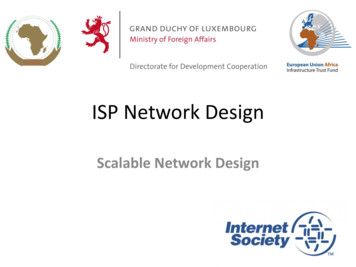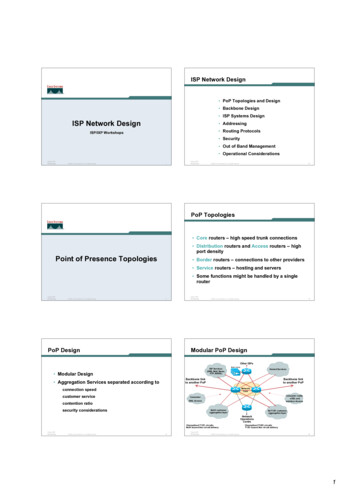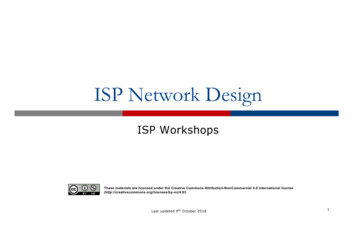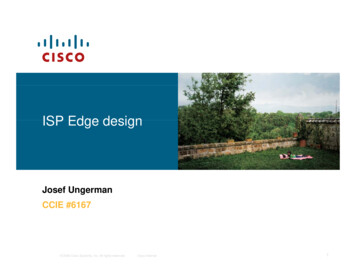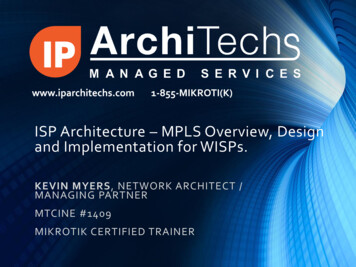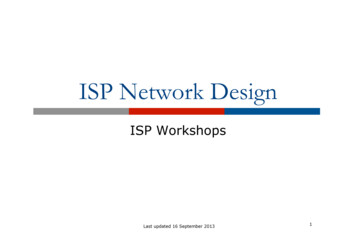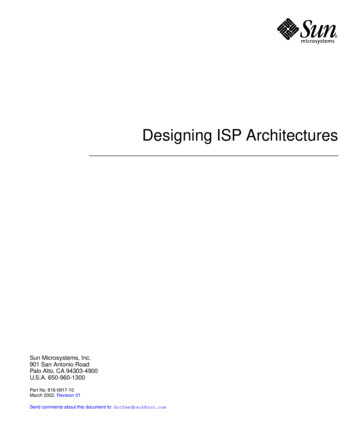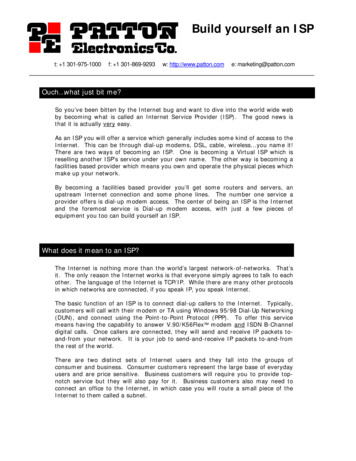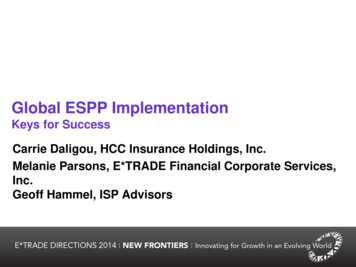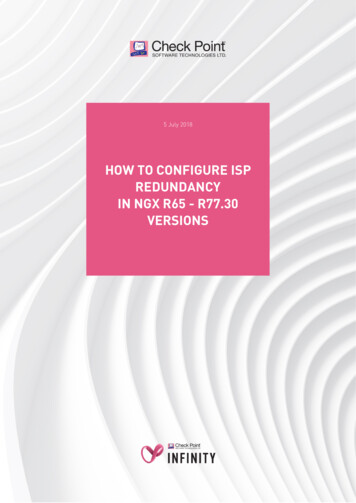
Transcription
Introductions to ISPDesign FundamentalsPresentation ID 1999, Cisco Systems, Inc.1
Agenda Rational Behind ISP Network Design Point of Presence Topologies Adding Services to the Architecture Impact of Services on the NetworkPresentation ID 1999, Cisco Systems, Inc.www.cisco.com2
Rational Behind ISPNetwork DesignLayers upon Layers upon Layersupon Layers .Presentation ID 1999, Cisco Systems, Inc.www.cisco.com3
The Free On-line Dictionaryof ComputingArchitecture: Design; the waycomponents fit together;it may also be used for anycomplex system, e.g. “softwarearchitecture”, “networkarchitecture”Presentation ID 1999, Cisco Systems, Inc.www.cisco.com4
Network Design andArchitecture can be critical can contribute to the successof the network can contribute to the failureof the networkPresentation ID 1999, Cisco Systems, Inc.www.cisco.com5
Ferguson’s Law ofEngineering“No amount of magicknobs will save asloppilydesigned networkPaul Ferguson—Consulting Engineer,Cisco SystemsPresentation ID 1999, Cisco Systems, Inc.www.cisco.com”6
What Is a Well-DesignedNetwork? One that takes into considerationsome main factorsPresentation ID3Topological/protocol hierarchy3Redundancy3Addressing aggregation (IGP and BGP)3Scaling3Policy implementation (core/edge)3Management/maintenance/operations3Cost 1999, Cisco Systems, Inc.www.cisco.com7
One Must Acknowledge that Two different worlds exist3 Oneworld revolves around privateorganizational networks and anotherconcerns the global Internet Growth in the Internet is faster thanany other technology introduced tothe public-at-largePresentation ID 1999, Cisco Systems, Inc.www.cisco.com8
Technology tyInternetAirplaneCellPhoneSource: Forbes Magazine July 7th—1997Presentation ID 1999, Cisco Systems, Inc.www.cisco.com9
Scaling is the #1 Problem onthe Internet“If you’re not scared yet,you don’t understand theproblem!Mike O’Dell—Chief Scientist,UUnetPresentation ID 1999, Cisco Systems, Inc.www.cisco.com”10
Core Influences to ISP Design Modular Design Functional Design Tiered/Hierarchical Design Multiple Levels of Redundancy Routing Protocol Hierarchy Build for IP Forwarding First - thenadd servicesPresentation ID 1999, Cisco Systems, Inc.www.cisco.com11
Modular DesignOrganize the Networkinto separate andrepeatable modules3 Backbone3 POP3 Hosting3 ISPServicesServicesOther ISPsISP Services(DNS, Mail, News,FTP, WWW)Hosted ServicesBackbone linkto another PoPBackbone linkto another PoPNetworkCoreConsumerConsumer CableDIAL Accessand xDSL AccessNx64 customeraggregation layerNxT1/E1 customeraggregation layerNetworkOperationsCentreChannelised T1/E1 circuitsNx64 leased line circuit deliveryChannelised T3/E3 circuitsT1/E1 leased line circuit delivery3 Support/NOCPresentation ID 1999, Cisco Systems, Inc.www.cisco.com12
Functional Design One Box cannot do everything! (no materhow hard people have tried in the past) Each router/switch in a network has awell-defined set of functions. The various boxes each with afunction interact with each other. ISP Networks are a systems approachto design.Presentation ID 1999, Cisco Systems, Inc.www.cisco.com13
Tiered/Hierarchical NetworkDesignOtherRegionsOtherRegions Flat - MeshedTopologies havenot scaled.CoreOtherRegions Hierarchy is usedin network designsto scale thenetwork.DistributionLayerAccess LayerPresentation ID 1999, Cisco Systems, Inc.www.cisco.com14
Multiple Levels of Redundancy Triple Layered POPRedundancyBackbone3Lower-level failures are better3Lower-level failures may triggerhigher-level failures3L2: Two of everything at3L3: IGP and BGP provideredundancy and load balancing3L4: TCP re-transmissionsrecovers during the fail-overPresentation ID 1999, Cisco Systems, Inc.www.cisco.comBorderIntra-POP InterconnectPOP IntraconnectAccess15
Multiple Levels of Redundancy Objectives 3As little user visibility of a fault as possible3Minimize the impact of any fault in any part of thenetwork.3Network needs to handle L2, L3, L4, and ResidentialAccessPresentation ID 1999, Cisco Systems, Inc.www.cisco.com16
Hierarchy of RoutingProtocolsOther ISPsBGP4BGP4and OSPF/ISISBGP4FDDIPresentation ID 1999, Cisco Systems, Inc.Static/BGP4LocalIXPwww.cisco.comCustomers17
Warning“Beware Block Diagram/SlidewareDesign Gurus! They have gottenpeople and networks into trouble- including Cisco”Presentation ID 1999, Cisco Systems, Inc.www.cisco.com18
Point of PresenceTopologiesISP/IXPWorkshopsPresentation ID 1999, Cisco Systems, Inc.www.cisco.com19
PoP DesignNeighboringPOPNeighboringPOPCore BackboneRoutersCore 1Core 2External BGP PeeringSW 1Access 1Access 2POPInterconnectMediumNAS 1 1999, Cisco Systems, Inc.NAS 2PSTN/ISDNDedicated AccessPresentation IDSW 2www.cisco.com20
Early Internet POPArchitecture - NSP3 BackbonetrunksInternetBackboneat 45 Mb/s45 Mb/sHSSI3 Sharedmediainterconnectwithin POP:FDDI, Ethernet, SwitchedEthernetFDDI3 ConventionalT3 backboneInternet routerPresentation ID 1999, Cisco Systems, Inc.www.cisco.com21
Internet POP Architecture ‘96/’973 Backbonetrunksat 155 Mb/sInternetBackbonePacket over SONET OC3155 Mb/sPOS/ATMATM OC33 Switchedinterconnectwithin POP:Switched FDDI/Fast EthernetXXATM OC33 AdvancedOC3 backboneInternet routerPresentation ID 1999, Cisco Systems, Inc.www.cisco.com22
Internet POP Architecture ‘97/’98 InternetBackbone3 Backbonetrunks at622 Mb/s622 Mb/sPOS/ATMPacket over SONET OC12ATM OC12622 Mb/s ATM1 Gb/s Ethernet3 Switchedinterconnectwithin POP:ATM at OC3 AND OC12Ethernet ChannelGigabit Ethernet (early ’98)POSIP (late ‘98)Duplex Fast E, 155/622 Mb/s ATM, or1 Gb/s Ethernet3 GigabitOC12 backboneInternet routerPresentation ID 1999, Cisco Systems, Inc.www.cisco.com23
Internet POP Architecture ‘99/’01Backbone SRP Rings - High Speedof SDH combined with fastfailover and redundancy3HighGSRGSRbandwidth3Reducedport counts3Reducedcomplexity3Proactiveself healing7xxx7xxx7xxx7xxx7xxxleased line aggregationPresentation ID 1999, Cisco Systems, Inc.www.cisco.com24
Large POPs - add a 3rd layer3Problem: port density!3Solution: buy more routers!3Customer routers connect toaggregation routersInternetBackboneOC48Packet over SONET OC3OC12ATM OC33Aggregation routers connect tobackbone routers3Scales nicely3X CRs to Y ARs to Z BRs3.whereOC3X Y Z3Becareful not tooversubscribe!Presentation ID 1999, Cisco Systems, Inc.www.cisco.com25
POP Interconnect SummaryFDDI100MbpsSRP2 x 622Mbpsor 2x2.5GBFast/Gig Ethernet100/1000MbpsPOSN x 155Presentation ID 1999, Cisco Systems, Inc.www.cisco.com26
Key Design PrinciplesPOS & ATM for Core Backbone Interconnection forManagement, Security,and Accounting services3Netflow Devices FlowCollector3Syslog collector for allnetwork devices33Presentation IDGSRGSRPOS75077507SNMP collector (PC BasedUNIX)Security Auditing Tools(NetSonar) 1999, Cisco Systems, Inc.Management&AccountingCustomer and Serviceswww.cisco.com27
ISP routing Architectures - IP IGP EIGRP, IS-IS,or OSPF3almost always IS-IS or OSPF3IS-IS, single level (usually L2)3OSPF, either single area or BB/POPareasBGP all routers in full mesh3 mesh accomplished with routereflectors, confederations, actual fullmeshAll routers have all routes, soservices could go anywherePresentation ID 1999, Cisco Systems, Inc.www.cisco.com28
ISP routing Architectures IP MPLS IGP EIGRP, IS-IS,or OSPF3 must be IS-IS or OSPF to use MPLSTEBGP only edge routers need full routes3full-mesh of edge routers usingaforementioned mechanisms3packets are forwarded via LDPlabels, not IP destination addressWhere to put your services?3Presentation IDcannot hang a cache service off of arouter that doesn’t have full routes! 1999, Cisco Systems, Inc.www.cisco.com29
Adding Services to theArchitectureCause and Effect15030925 04F9 c1Presentation ID 1999, Cisco Systems, Inc.30
Services?How many Services?Most network services are applied at the edge!Edge (one-time) servicesPer-hop services Voice over IP MPLS packet forwarding MPLS VPNs DiffServ, other QoS CDNs Multicast Services VPDNs Managed services Dial—DSL—cablePresentation ID 1999, Cisco Systems, Inc.www.cisco.com31
Ask the Right Questions What is the value of the service?3 Technical3 Costmeritsavings3 Marchitecture What is the cost of the service?3 Equipment?Presentation ID3 Trainingpeople to support it?3 Networkbuildouts/topology changes? 1999, Cisco Systems, Inc.www.cisco.com32
Impact of Services onthe Network15030925 04F9 c1Presentation ID 1999, Cisco Systems, Inc.33
Who Knows? What will be the impact on existing trafficloads/patterns? Can the network deliver the performancethat your customers/applications desire?delay? jitter (delay variation)? Make sure to add capacity as you addservices - bandwidth is a must.Presentation ID 1999, Cisco Systems, Inc.www.cisco.com34
Deployment of New Services Is more of a business decision The technical aspect is to ensurecontinued network performance—scalability and stability Try to keep services within your AS3 end2end3 lessPresentation IDcontrollikelihood of failure/flaps 1999, Cisco Systems, Inc.www.cisco.com35
Deploying New Services Don’t feed the hype fire Look before you leap! Don’t deploy new technologies andservices just for the sake of it; havevalid business and technical reasonsPresentation ID 1999, Cisco Systems, Inc.www.cisco.com36
Deploying New Services Usually a Service requires a TCP/UDPtermination (I.e. TCP’s three wayhandshake) Termination should happen out sideof the primary flow path Otherwise, the network is thendesigned around the single service.Presentation ID 1999, Cisco Systems, Inc.www.cisco.com37
Deploying New ServicesServiceTerminateHereMultiplePOP ServicesAccessISDNPOTSLease LineCablexDSLPrimary Packet FlowInterconnectCPECPEPresentation ID 1999, Cisco Systems, Inc.POPPOPwww.cisco.comLeased CoreCORECORE38
TransparentRedirection of a Flowin the POPFactors that went into thedesign of WCCPPresentation ID 1999, Cisco Systems, Inc.www.cisco.com39
Design Objectives for the ISP Transparent Redirection of a IP flowbased on source, destination, and/orport number. Transparent Integration - norebuilding the POP to add thisservice. Failed open - if the service fails, itshould not effect the core IP servicenor any other services.Presentation ID 1999, Cisco Systems, Inc.www.cisco.com40
Design Objectives for the ISP Not to effect the primary packet flow of thePOP - if not redirected - then is Lease LineCablexDSLPrimary Packet FlowInterconnectCPECPEPresentation ID 1999, Cisco Systems, Inc.POPPOPwww.cisco.comLeased CoreCORECORE41
Design Objectives for the ISP Work with the multi-level L2/L3 redundancyof the ISP POP. Equal paths in the IGP CEF leads packet asymmetry.WCCPServiceClustersAccessISDNPOTSLease LineCablexDSLInput PortWCCPRedirectInterconnectCPECPEPresentation ID 1999, Cisco Systems, Inc.POPPOPwww.cisco.comLeased CoreCORECORE42
Design Objectives for the ISP Provide the ISP with Flexibility on the pointof redirection. Do not force an architectureon the customer.WCCPServiceClustersAccessISDNPOTSLease LineCablexDSLInterconnectCPECPEPresentation ID 1999, Cisco Systems, Inc.POPPOPwww.cisco.comLeased CoreCORECORE43
Design Objectives for theService Group Linear Scalability with the Cache minimize object replication. Fault Tolerance and Maintenance. “Joe Smith the Telco Tech” test.Presentation ID 1999, Cisco Systems, Inc.www.cisco.com44
Presentation ID 1999, Cisco Systems, Inc.www.cisco.com45
Functional Design One Box cannot do everything! (no mater how hard people have tried in the past) Each router/switch in a network has a well-defined set of functions. The various boxes each with a function interact with each other. ISP Networks are a systems approach to design.
